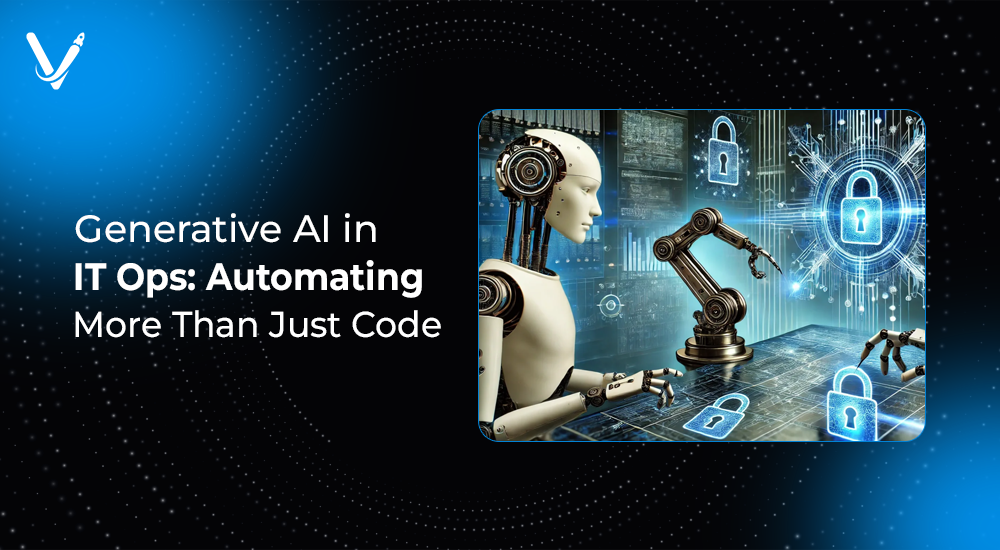Generative AI in IT Ops: Automating More Than Just Code


- Jul 2, 2025



IT operations have traditionally been the backbone of enterprise infrastructure, ensuring uptime, performance, and security across digital systems. With the explosion of cloud computing, DevOps practices, and digital transformation initiatives, IT teams face mounting pressure to manage complexity, respond faster, and minimize downtime. Enter Generative AI for IT Operations—a game-changing innovation that is no longer limited to coding assistance.
Generative AI in business is revolutionizing workflows by creating content, optimizing code, predicting system anomalies, and automating repetitive tasks. But its impact on IT operations is particularly transformative. In this article, we’ll explore how generative AI is reshaping IT management, real-world use cases, top frameworks, and how organizations can adopt these capabilities to boost efficiency, security, and innovation.
At its core, generative AI uses large language models (LLMs) to understand and generate human-like content. This includes code, documentation, scripts, reports, and even system configurations. A key feature of generative AI is its ability to learn from massive datasets and generate contextually relevant, functional outputs, often in real-time.
Several LLM frameworks are now at the forefront of building IT-specific generative AI models:
OpenAI’s GPT family (used in tools like GitHub Copilot and ChatGPT)
These frameworks enable everything from AI coding to intelligent workflow generation and predictive analytics.
While the broader scope of generative AI business applications includes marketing, HR, and customer support, its role in IT is laser-focused on efficiency, reliability, and scale.
Generative AI can:
Real-world example: A cloud service provider used GPT-based models to auto-triage 65% of Level 1 incidents, reducing Mean Time to Resolution (MTTR) by 43%.
Many ask: Can I generate code using generative AI models? Absolutely. Generative AI tools:
What is the best AI for coding? GitHub Copilot, Amazon CodeWhisperer, and Tabnine are currently leaders, using LLMs trained specifically for developer workflows.
Using AI in DevOps workflows, IT teams can:
Generative AI for IT operations reduces human intervention, preventing outages caused by manual errors.
Generative AI analyzes historical logs, error trends, and system behavior to:
According to a Gartner study, predictive maintenance using AI can reduce downtime by 30% and extend equipment life by up to 20%.
Another growing area is generative AI in business documentation:
Generative AI for workforce training startups is a booming segment. For IT teams, this translates into:
Learn how to build a personalized AI training platform for your teams to stay future-ready.
If you're exploring practical implementations, here are two standout examples:
Use Case 1: Self-Healing Infrastructure
Using generative AI, a fintech company implemented self-healing servers that detected issues, generated and tested fixes in staging, and deployed them—all without manual intervention.
Use Case 2: AI-Augmented IT Helpdesk
An enterprise helpdesk integrated GPT-4 with their ticketing system to:
This reduced average ticket response time by 58%.
The evolution of generative AI trends in IT is accelerating. Here’s what’s on the horizon:
Developers can use AI-generated code and configurations early in the SDLC, catching vulnerabilities before deployment. This trend is reshaping how IT teams embed security into their workflows.
Instead of a single AI model, multiple agents—each trained on a specific domain (networking, security, storage)—collaborate to solve issues end-to-end.
Platforms like ServiceNow, Dynatrace, and Datadog are integrating generative capabilities into their dashboards to suggest remediations, create visual reports, and even execute actions autonomously.
Generative AI is enabling low-code platforms to build IT workflows with just a prompt. For example, typing “monitor disk space and alert when above 90%” can now auto-generate a complete alerting system.
You don’t have to be an ML engineer. Here’s how to begin:
Depending on your use case:
When adopting Generative AI in business, especially in IT, you must:
Start small—pilot generative AI for IT operations in one domain (e.g., documentation). Then, use metrics to showcase ROI and scale it up.
While generative AI can drive immense value, some risks must be managed:
Being proactive about these pitfalls is critical for safe, scalable adoption.
Generative AI in IT operations is still in its early innings. In the near future, we expect:
The vision is clear: automate not just code, but cognition across the IT stack.
Generative AI is not just a coding companion—it’s a strategic enabler for modern IT operations. By applying it across incident management, documentation, training, automation, and monitoring, businesses can unlock new levels of resilience and efficiency.
At Vasundhara Infotech, we help enterprises harness the power of generative AI to future-proof their IT workflows. Whether you’re a startup building internal tools or a large enterprise seeking end-to-end automation, our experts can guide you through the transformation.
Ready to automate more than just code? Let’s bring intelligent IT operations to life. Contact our experts.
Copyright © 2025 Vasundhara Infotech. All Rights Reserved.